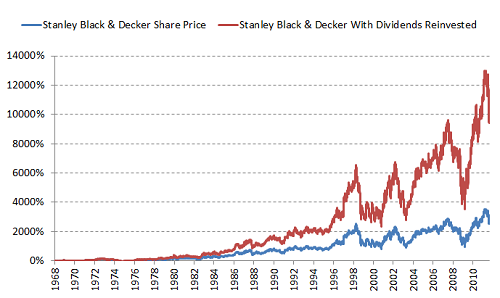The Extraordinary Power of Stanley Black & Decker's Dividends
I took my first investing class as a teenager, and one moment stands out in my memory. A fellow student asked the instructor, a stockbroker, about dividends.
"Dividends?" he asked. "I'm trying to make my clients wealthy. You don't do that waiting for tiny checks in the mailbox every quarter."
Even then, I had enough horse sense to know he was wrong. Paying attention to dividends is exactly how you become wealthy over time.
Wharton professor Jeremy Siegel made a wonderful discovery in his book The Future for Investors. The greatest long-term returns typically don't come from the most innovative companies, or even companies with the highest earnings growth. They come from companies that happen to crank out dividends year after year. Simply put, since the 1950s, "the portfolios with higher dividend yields offered investors higher returns."
Market commentary regularly centers around price gyrations, yet dividends have historically accounted for more than half of total returns.
Reinvest those dividends, and the gains get even greater. Take Stanley Black & Decker (NYS: SWK) , for example. Since the late 1960s, the company's share price has increased 2,800%. But add in reinvested dividends, and total returns jump to more than 10,400%:

Source: Capital IQ, a division of Standard & Poor's.
There's no ambiguity here: Over time, Stanley Black & Decker's share appreciation alone has paled in importance to the power of its reinvested dividends. The results are similar for others in the tool industry, such as Snap-On (NYS: SNA) and Makita (NAS: MKTAY) ; reinvested dividends skew both companies' total returns dramatically higher. If you're a long-term shareholder, don't worry about daily share wobbles. Devote your attention those dividend payouts, and your commitment to reinvest them.
And how do Stanley Black & Decker's dividends look? At 2.7%, its dividend moderately exceeds the market average. It has paid a dividend since every year since 1877, and has raised its dividend every year since 1968 -- truly one of the greatest dividend accomplishments in the history of corporate America. The company isn't shy about its accomplishments: "Our quarterly dividend record is the longest of any industrial company listed on the New York Stock Exchange," boats its website. Over the past five years, dividends have used up an average of 30% of free cash flow. That's a low figure that should help its history of dividend greatness continue well into the future.
To earn the greatest returns, get your priorities straight. What the market does is less important than what your company earns. What your company earns is less important than how much it pays out in dividends. And what it pays out in dividends is less important than whether you reinvest those dividends.
Add Stanley Black & Decker to My Watchlist
At the time thisarticle was published Fool contributorMorgan Houseldoesn't own shares in any of the companies mentioned in this article. Follow him on Twitter @TMFHousel.Try any of our Foolish newsletter services free for 30 days. We Fools may not all hold the same opinions, but we all believe thatconsidering a diverse range of insights makes us better investors. The Motley Fool has adisclosure policy.
Copyright © 1995 - 2011 The Motley Fool, LLC. All rights reserved. The Motley Fool has a disclosure policy.

